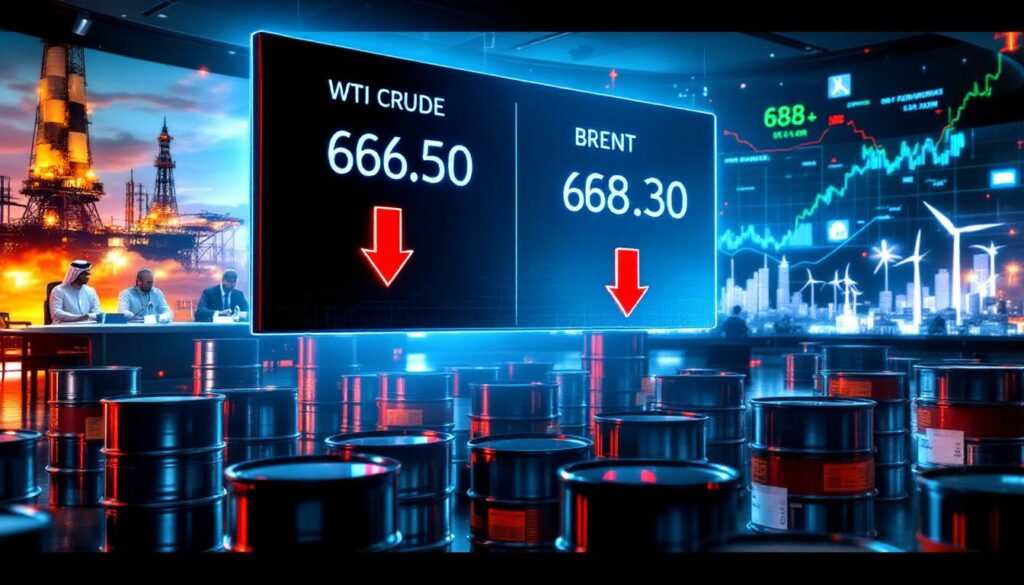Understanding Today's Oil Market at a Glance
The global oil market continues to experience significant fluctuations, with WTI crude currently trading at $66.50, down 0.75% in the last 24 hours. Brent crude, the international benchmark, stands at $68.30, showing a similar decline of 0.73%. These oil price movements reflect the complex interplay of supply, demand, and geopolitical factors shaping today's energy landscape.
According to real-time data from Oilprice.com, crude oil prices today demonstrate how regional supply-demand imbalances are creating notable divergences between benchmarks. While most major crudes show downward pressure, Louisiana Light has bucked the trend with a surprising 2.94% gain.
How Do Different Crude Oil Benchmarks Compare?
Major Global Benchmarks
| Benchmark | Current Price | 24hr Change | % Change |
|---|---|---|---|
| WTI Crude | $66.50 | -$0.50 | -0.75% |
| Brent Crude | $68.30 | -$0.50 | -0.73% |
| Murban Crude | $69.65 | -$0.45 | -0.64% |
| Louisiana Light | $70.66 | +$2.02 | +2.94% |
The price differential between benchmarks isn't arbitrary—it reflects fundamental differences in crude quality, transportation constraints, and regional market dynamics. Murban crude from the UAE trades at a premium largely due to its lower sulfur content, making it more attractive to refiners facing stringent emissions regulations.
Regional Crude Varieties
| Benchmark | Current Price | Change | Region |
|---|---|---|---|
| Bonny Light | $78.62 | -2.84% | West Africa |
| OPEC Basket | $69.79 | +1.50% | OPEC Nations |
| Mars US | $71.88 | -1.41% | Gulf of Mexico |
| Canadian Crude Index | $53.57 | -2.24% | Canada |
The substantial discount on Canadian crude ($53.57) highlights the persistent infrastructure challenges facing North American producers. Limited pipeline capacity forces Canadian producers to accept significant discounts, sometimes exceeding $15 per barrel compared to WTI. Meanwhile, Nigeria's premium Bonny Light crude has faced increased pressure as European refiners opt for discounted Russian barrels that circumvent sanctions through complex shipping arrangements.
"Benchmark differentials reflect regional supply-demand imbalances. Louisiana Light's surge likely stems from Gulf Coast refinery demand." — Oilprice.com market analysis, July 2025
What's Driving Crude Oil Prices Today?
Breaking News: OPEC+ Output Decision
The most significant market development is OPEC+'s surprise announcement of an oversized production increase. This unexpected move has immediately impacted market sentiment and price trajectories, as traders adjust their positions to account for potentially increased supply in coming months.
The magnitude of the production hike exceeded analyst expectations, signaling a shift in OPEC+'s market strategy. According to Oilprice.com analysis, "OPEC+'s move signals confidence in demand but risks oversupply. The market's reaction shows skepticism about absorption capacity."
Key Supply Factors Affecting Oil Prices
OPEC+ Production Strategies
OPEC+ has been gradually unwinding production cuts implemented during the pandemic. The cartel's recent decision to boost output beyond market expectations signals confidence in demand resilience but has put downward pressure on prices. Kazakhstan's production has reached an all-time high, creating internal tensions within the organization.
The compliance challenges within OPEC+ represent a growing concern. Kazakhstan's record-high production is just one example of member countries exceeding their quotas, effectively undermining the group's collective strategy. The OPEC tariff impact on global markets adds another layer of uncertainty to crude oil prices today.
Regional Production Disruptions
Several production disruptions are affecting global supply:
- Wildfires in Alberta have significantly impacted Canadian oil production, cutting more than 300,000 barrels per day at the peak of the crisis in May 2025
- Libya recently fixed a leak on a crude oil pipeline linked to its top refinery, preventing a potential 100,000 barrel per day outage
- ADNOC has restored most of Murban crude supply after earlier cuts, easing concerns about premium light crude availability
These disruptions highlight how vulnerable global oil supply remains to both natural disasters and technical failures, despite the overall market narrative of potential oversupply.
U.S. Inventory Developments
A surprise crude oil inventory build has ended a five-week streak of draws, suggesting potential softening of U.S. demand or increased production. This unexpected increase in stockpiles has contributed to the current downward price pressure.
The inventory build coincided with reduced refinery utilization rates, which dropped from approximately 92% to 89%, indicating potential maintenance activities or operational adjustments in response to changing market conditions. Furthermore, the US oil production decline has created additional supply challenges in key regions.
How Are Geopolitical Factors Influencing Oil Markets?
Russia-Ukraine Conflict Implications
The ongoing conflict continues to create uncertainty in energy markets. Recent developments include:
- Russia's oil exports stagnating as prices sink and sanctions bite, with volumes reportedly declining approximately 20% month-over-month according to market intelligence firm Kpler
- Declining natural gas supply from Russia to Europe, creating structural changes in global LNG flows
- Suspicious death of a Russian oil executive, highlighting the dangerous pattern in the energy sector
The sanctions regime has forced Russian producers to offer significant discounts on Urals crude, sometimes exceeding $15 per barrel compared to Brent. This price gap has prompted Moscow to consider tax breaks for natural gas producers to maintain production levels despite mounting financial challenges.
U.S.-China Energy Relations
The complex relationship between these economic superpowers continues to impact oil markets:
- China has snubbed U.S. crude for the third consecutive month, reflecting geopolitical realignment
- U.S. has lifted restrictions on ethane exports to China, potentially opening a new energy trade channel
- China continues significant purchases of Iranian crude oil (approximately 800,000 barrels per day) despite sanctions
As one Oilprice.com geopolitical analyst noted: "China's snub of U.S. crude reflects long-term pivot to discounted Iran/Russia barrels. Sanction enforcement reshapes shipping routes."
Middle East Dynamics
Key developments in this critical oil-producing region include:
- Saudi Arabia and Indonesia signing $27 billion worth of oil and energy deals, strengthening Asia's energy security
- Saudi Aramco potentially raising $4 billion from power plant sales to fund its economic diversification agenda
- U.S. sanctions targeting Iran's oil smuggling network, highlighting ongoing efforts to restrict Tehran's oil revenue
These developments underscore how crude oil prices today are inextricably linked to complex geopolitical maneuvering, with major powers using energy as both economic leverage and diplomatic currency.
What's Happening with Global Energy Transition Amid Oil Market Volatility?
Renewable Energy Growth
Despite oil market fluctuations, the renewable sector continues to expand:
- India's wind and solar output growth has hit a three-year high, demonstrating emerging markets' commitment to energy transition
- The UK has launched a new onshore wind strategy to boost clean power output despite policy inconsistencies
- Australia is backing green hydrogen projects despite industry challenges, including production costs that remain significantly higher than conventional hydrogen (approximately $4.50/kg versus $1.50/kg for gray hydrogen)
The acceleration of renewable deployment in India represents a significant shift in the global energy landscape. With year-over-year growth exceeding 12% according to industry analysts, India's renewable sector is outpacing most mature markets and creating new competition for traditional energy sources.
Natural Gas Market Developments
Natural gas, often viewed as a transition fuel, is experiencing its own market dynamics:
- Natural gas prices are currently at $3.387, down 0.65%, reflecting a balanced market amid seasonal demand shifts
- U.S. LNG exports decreased in June due to maintenance at key liquefaction facilities
- Russia is considering tax breaks for natural gas producers as challenges mount from sanctions and infrastructure constraints
The most significant development in global LNG markets comes from Canada, where the first cargo from the massive LNG Canada project marks the country's entry into global export markets after years of delays and regulatory hurdles.
"LNG Canada's first cargo proves fossil fuels remain investable during transition. Policy zigzags won't erase Asia's LNG demand." — Oilprice.com energy transition report, July 2025
Investment and Infrastructure Trends
Energy infrastructure development continues to shape future supply patterns:
- Canada's first LNG export terminal has shipped its initial cargo, with 14 million tonnes per year capacity targeting Asian markets
- Big oil companies are bidding in Libya's first exploration tender in 18 years, with TotalEnergies among the participants
- Indonesia is seeking drilling partners to revive oil output from old wells, highlighting the continued investment in conventional resources
These infrastructure developments demonstrate that despite the energy transition narrative, fossil fuel infrastructure continues to attract significant capital, creating a complex dual-track energy system that will likely persist for decades. In the United States, the Alaska drilling policy shift has also created new dynamics in North American energy markets.
What Are Oil Price Forecasts Suggesting?
Short-Term Price Outlook
Market analysts are closely monitoring several factors that could influence near-term price movements:
- Expected OPEC+ production increases may continue to pressure prices downward as additional barrels enter the market
- Seasonal summer demand typically provides support for gasoline and crude prices, adding a $3-5 premium per barrel
- Unexpected supply disruptions could quickly reverse the current bearish trend, with Middle East tensions capable of triggering $10 price spikes
Technical analysts have identified key price levels that will likely define trading ranges in coming weeks. WTI crude faces important support around $65, while Brent crude encounters resistance near the psychologically important $70 mark.
Technical Analysis Indicators
Technical analysts point to several key levels to watch:
- Support levels around $65 for WTI crude, representing a critical floor based on recent trading patterns
- Resistance at the $70 mark for Brent crude, a level that has repeatedly capped upward price movements
- Trading volumes suggest potential consolidation before the next significant move, with declining volatility metrics
The current price corridor of $65-75 for WTI reflects what many analysts consider a balanced market, where neither producers nor consumers face extreme economic pressure. This range aligns with OPEC+'s implicit price targets based on member countries' fiscal requirements.
Long-Term Market Considerations
Looking beyond immediate price movements, several structural factors may influence oil markets:
- The pace of energy transition investments and policy implementation, particularly in key markets like the EU, China, and India
- Evolving demand patterns in emerging markets, particularly in Asia, where oil consumption continues to grow despite electrification efforts
- Investment levels in new oil production capacity amid uncertain long-term demand, with major companies increasingly selective about capital allocation
Libya's first exploration tender in 18 years has attracted significant interest from international oil companies, suggesting that despite transition pressures, producers remain confident in long-term hydrocarbon demand, particularly for low-cost, high-quality reserves.
How Can Investors Navigate Current Oil Market Conditions?
Portfolio Diversification Strategies
Energy market volatility suggests investors should consider:
- Exposure to both traditional energy and renewable sectors, balancing near-term cash flow with long-term transition positioning
- Geographic diversification across producing regions to mitigate policy and geopolitical risks
- Balanced exposure to upstream, midstream, and downstream segments of the industry to capture value across the supply chain
Integrated majors with substantial LNG portfolios and growing renewable investments offer particularly attractive risk-reward profiles in the current environment. These companies combine stable cash flows from traditional operations with strategic positioning for the energy transition.
"Integrated majors with LNG and renewables portfolios offer refuge from volatility. Avoid pure-play E&Ps with >$50 break-evens." — Oilprice.com investor guidance, July 2025
Risk Management Approaches
The current market environment highlights the importance of:
- Hedging strategies to manage price volatility, with collar structures (combined put and call options) providing downside protection for under $2 per barrel
- Attention to company-specific debt levels and break-even prices, particularly for shale producers requiring WTI prices above $40 to generate positive cash flow
- Monitoring geopolitical developments that could trigger supply disruptions, especially in critical chokepoints like the Strait of Hormuz
Shell's recent regulatory challenges—amending U.S. filings following audit breaches—demonstrate how compliance and governance issues represent an often-overlooked risk factor for energy investors, particularly as ESG considerations gain prominence in investment decision-making.
Emerging Opportunities
Despite current price pressures, several potential opportunities exist:
- Companies with low production costs and strong balance sheets positioned to weather potential market downturns
- Integrated majors with growing renewable portfolios that combine cash flow stability with transition positioning
- Infrastructure providers supporting both traditional and alternative energy, particularly those facilitating LNG exports and renewable integration
The debt-to-EBITDA ratios of vulnerable independent producers deserve particular scrutiny, as those exceeding 2.5x face potential refinancing challenges if crude oil prices today remain under pressure for an extended period. Recent oil price rally analysis suggests potential upside under certain market conditions.
FAQ About Current Crude Oil Prices
Why are oil prices falling today?
Oil prices are declining primarily due to OPEC+'s surprise announcement of a larger-than-expected production increase, combined with a recent build in U.S. crude inventories that ended a five-week streak of draws. The market appears concerned about potential oversupply as additional barrels enter global markets amid uncertain demand growth.
What is the difference between WTI and Brent crude?
WTI (West Texas Intermediate) is the U.S. benchmark crude, priced and delivered at Cushing, Oklahoma. Brent crude is the international benchmark, sourced from the North Sea. Brent typically trades at a premium to WTI (currently $1.80) due to quality differences (API gravity and sulfur content) and transportation costs. WTI reflects landlocked U.S. market conditions, while Brent represents seaborne international trade.
How do crude oil prices affect gasoline prices?
Crude oil typically accounts for about 50-60% of the retail price of gasoline. While there is a correlation between crude and gasoline prices, refining costs, taxes, and distribution expenses also influence what consumers pay at the pump. The relationship between crude and gasoline prices is measured by the "crack spread," which represents refiners' profit margins and can vary significantly based on seasonal demand patterns and refinery operations.
What factors could cause oil prices to rise again?
Several factors could trigger price increases, including:
- Unexpected production disruptions, particularly in major producing regions like the Middle East
- Escalation of geopolitical tensions, especially involving Iran, Russia, or other key oil exporters
- Stronger-than-anticipated global demand, particularly if economic growth exceeds expectations
- Significant drawdowns in global inventories, indicating tightening market fundamentals
Any combination of these factors could quickly shift market sentiment from the current bearish outlook to a more bullish stance.
Further Exploration
Readers interested in tracking daily oil price movements and energy market news can explore related educational content, such as the Market Index crude oil tracker for comprehensive price charts and industry analysis. Understanding crude oil prices today requires considering not just immediate market factors but also longer-term structural trends reshaping global energy systems.
Disclaimer: The information provided in this article is based on market data as of July 2025 and is subject to change. Price forecasts represent opinions based on current market conditions and should not be considered investment advice. Readers should conduct their own research or consult with a financial advisor before making investment decisions.
Ready to Track the Next Major Mineral Discovery?
Gain immediate insights into significant ASX mineral discoveries using Discovery Alert's proprietary Discovery IQ model, which transforms complex data into actionable investment opportunities. Explore why historic discoveries can generate substantial returns by visiting Discovery Alert's dedicated discoveries page and begin your 30-day free trial today to position yourself ahead of the market.




